Intel's Pentium M Desktop Part II: ASUS' Pentium M to Pentium 4 Socket Adapter
by Anand Lal Shimpi on March 24, 2005 1:31 PM EST- Posted in
- CPUs
Workstation Applications
Visual Studio 6
Carried over from our previous CPU reviews, we continue to use Visual Studio 6 for a quick compile test. We are still using the Quake 3 source code as our test and measure compile time in seconds.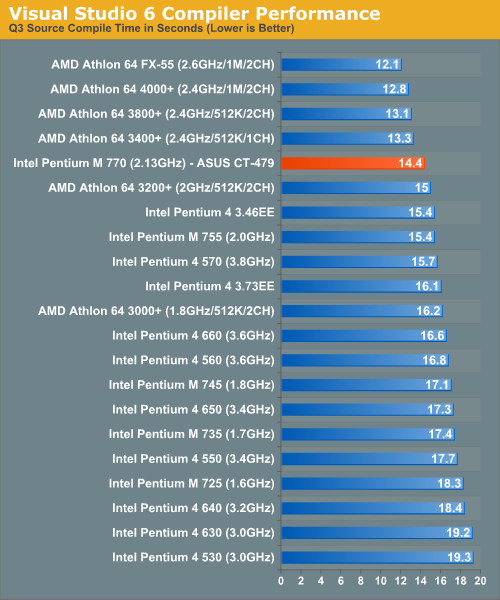
SPECviewperf 8
For our next set of professional application benchmarks, we turn to SPECviewperf 8. SPECviewperf is a collection of application traces taken from some of the most popular professional applications, and compiled together in a single set of benchmarks used to estimate performance in the various applications that the benchmark is used to model. With version 8, SPEC has significantly improved the quality of the benchmark, making it even more of a real world indicator of performance.We have included SPEC's official description of each one of the 8 tests in the suite.
The Pentium M doesn't excel in any of the SPECviewperf tests, but its performance is much more respectable with the ASUS solution, thanks to a more balanced memory bandwidth system.
3dsmax Viewset (3dsmax-03)
"The 3dsmax-03 viewset was created from traces of the graphics workload generated by 3ds max 3.1. To ensure a common comparison point, the OpenGL plug-in driver from Discreet was used during tracing.
The models for this viewset came from the SPECapc 3ds max 3.1 benchmark. Each model was measured with two different lighting models to reflect a range of potential 3ds max users. The high-complexity model uses five to seven positional lights as defined by the SPECapc benchmark and reflects how a high-end user would work with 3ds max. The medium-complexity lighting models use two positional lights, a more common lighting environment.
The viewset is based on a trace of the running application and includes all the state changes found during normal 3ds max operation. Immediate-mode OpenGL calls are used to transfer data to the graphics subsystem."
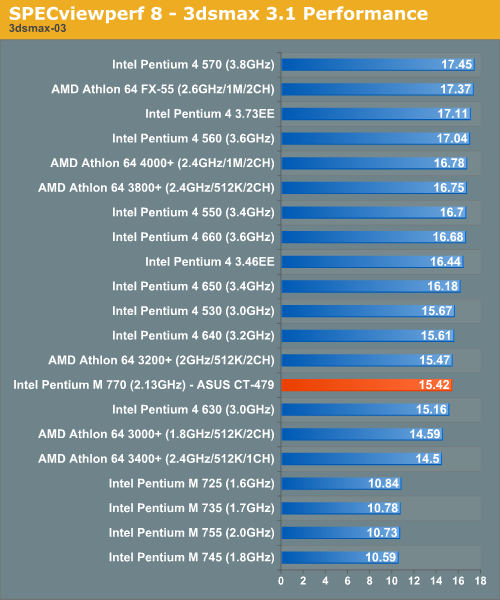
CATIA Viewset (catia-01)
"The catia-01 viewset was created from traces of the graphics workload generated by the CATIATM V5R12 application from Dassault Systems.
Three models are measured using various modes in CATIA. Phil Harris of LionHeart Solutions, developer of CATBench2003, supplied SPEC/GPC with the models used to measure the CATIA application. The models are courtesy of CATBench2003 and CATIA Community.
The car model contains more than two million points. SPECviewperf replicates the geometry represented by the smaller engine block and submarine models to increase complexity and decrease frame rates. After replication, these models contain 1.2 million vertices (engine block) and 1.8 million vertices (submarine).
State changes as made by the application are included throughout the rendering of the model, including matrix, material, light and line-stipple changes. All state changes are derived from a trace of the running application. The state changes put considerably more stress on graphics subsystems than the simple geometry dumps found in older SPECviewperf viewsets.
Mirroring the application, draw arrays are used for some tests and immediate mode used for others."
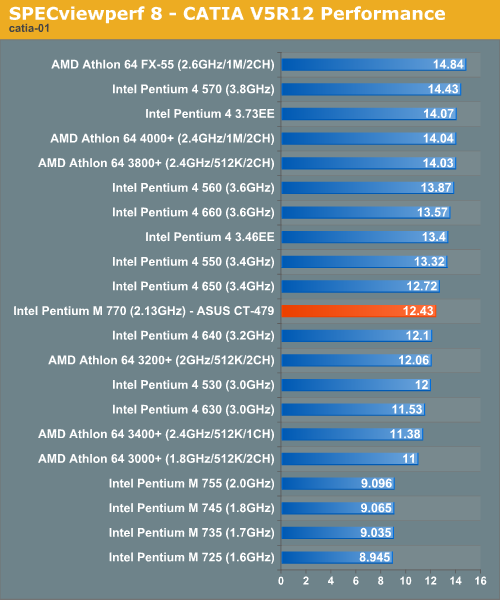
Lightscape Viewset (light-07)
"The light-07 viewset was created from traces of the graphics workload generated by the Lightscape Visualization System from Discreet Logic. Lightscape combines proprietary radiosity algorithms with a physically based lighting interface.
The most significant feature of Lightscape is its ability to simulate global illumination effects accurately by precalculating the diffuse energy distribution in an environment and storing the lighting distribution as part of the 3D model. The resulting lighting "mesh" can then be rapidly displayed."
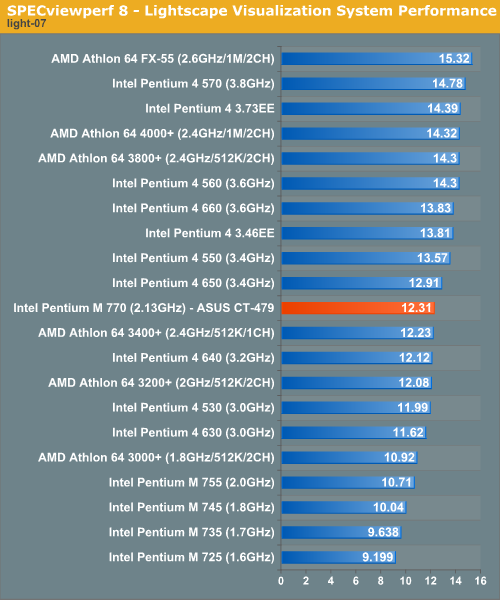
Maya Viewset (maya-01)
"The maya-01 viewset was created from traces of the graphics workload generated by the Maya V5 application from Alias.
The models used in the tests were contributed by artists at NVIDIA. Various modes in the Maya application are measured.
State changes as made by the application are included throughout the rendering of the model, including matrix, material, light and line-stipple changes. All state changes are derived from a trace of the running application. The state changes put considerably more stress on graphics subsystems than the simple geometry dumps found in older viewsets.
As in the Maya V5 application, array element is used to transfer data through the OpenGL API."
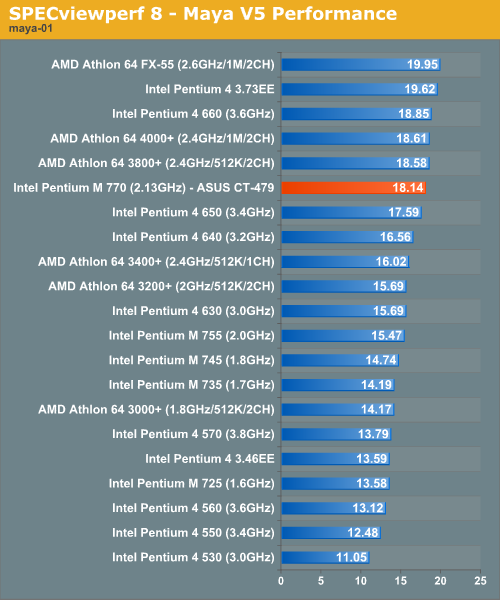
Pro/ENGINEER (proe-03)
"The proe-03 viewset was created from traces of the graphics workload generated by the Pro/ENGINEER 2001TM application from PTC.
Two models and three rendering modes are measured during the test. PTC contributed the models to SPEC for use in measurement of the Pro/ENGINEER application. The first of the models, the PTC World Car, represents a large-model workload composed of 3.9 to 5.9 million vertices. This model is measured in shaded, hidden-line removal, and wireframe modes. The wireframe workloads are measured both in normal and antialiased mode. The second model is a copier. It is a medium-sized model made up of 485,000 to 1.6 million vertices. Shaded and hidden-line-removal modes were measured for this model.
This viewset includes state changes as made by the application throughout the rendering of the model, including matrix, material, light and line-stipple changes. The PTC World Car shaded frames include more than 100MB of state and vertex information per frame. All state changes are derived from a trace of the running application. The state changes put considerably more stress on graphics subsystems than the simple geometry dumps found in older viewsets.
Mirroring the application, draw arrays are used for the shaded tests and immediate mode is used for the wireframe. The gradient background used by the Pro/E application is also included to better model the application workload."
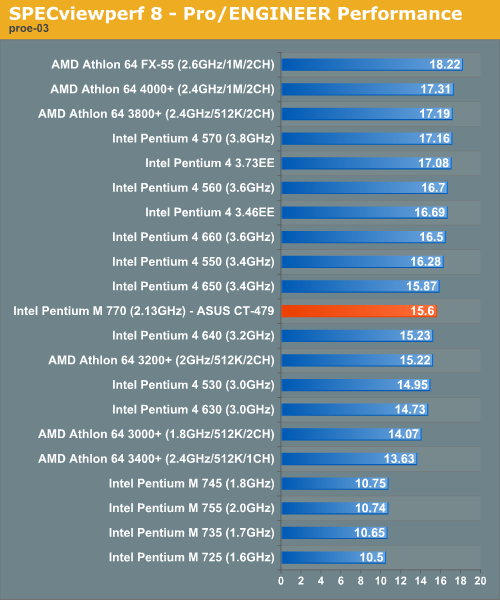
SolidWorks Viewset (sw-01)
"The sw-01 viewset was created from traces of the graphics workload generated by the Solidworks 2004 application from Dassault Systemes.
The model and workloads used were contributed by Solidworks as part of the SPECapc for SolidWorks 2004 benchmark.
State changes as made by the application are included throughout the rendering of the model, including matrix, material, light and line-stipple changes. All state changes are derived from a trace of the running application. The state changes put considerably more stress on graphics subsystems than the simple geometry dumps found in older viewsets.
Mirroring the application, draw arrays are used for some tests and immediate mode used for others."
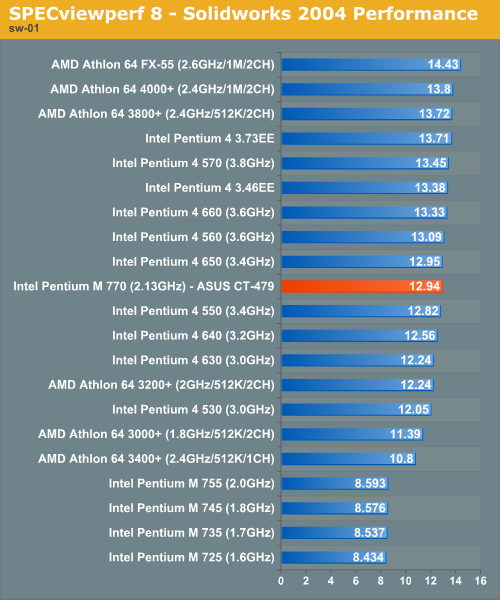
Unigraphics (ugs-04)
"The ugs-04 viewset was created from traces of the graphics workload generated by Unigraphics V17.
The engine model used was taken from the SPECapc for Unigraphics V17 application benchmark. Three rendering modes are measured: shaded, shaded with transparency, and wireframe. The wireframe workloads are measured both in normal and anti-alised mode. All tests are repeated twice, rotating once in the center of the screen, and then moving about the frame to measure clipping performance.
The viewset is based on a trace of the running application and includes all the state changes found during normal Unigraphics operation. As with the application, OpenGL display lists are used to transfer data to the graphics subsystem. Thousands of display lists of varying sizes go into generating each frame of the model.
To increase model size and complexity, SPECviewperf 8.0 replicates the model two times more than the previous ugs-03 test."
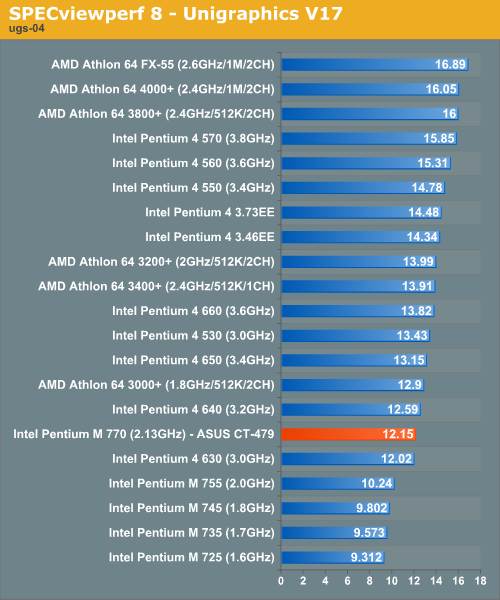










48 Comments
View All Comments
Avalon - Thursday, March 24, 2005 - link
In Soviet Russia, the Pentium-M owns you!In all seriousness, though...I was reading the benchmarks and wondering where the 855GME desktop P-M 770 benchmarks were. You only had the 770 on the Asus board. While this is all fine and dandy, it doesn't show us the full extent of the benefits of the Asus pin adapter over using an 855GME desktop board. While you could extra some data, I would have liked 770 desktop benches as a comparison. All in all, though, the Asus adapter is definitely nice due to the price alone.
Wonga - Thursday, March 24, 2005 - link
I don't think anyone can criticise Intel too harshly for releasing the Netburst architecture. Yes, Willamet stank, and Prescott isn't exactly an efficient core, but a Northwood processor was the best CPU money could buy for about 18 months before the K8 hit the scene. So, it doesn't really matter how Intel got there, but Netburst was the architecture to have for those 18 months.Anyway, Anand, I'd appreciate it if you could see if those adaptors would work on other S478 motherboards :)
Oh, and thanks for a great article! Perhaps that Pentium M horse that was beaten so much can now finally rest in peace!
sprockkets - Thursday, March 24, 2005 - link
While the boards and tech mentioned here are nice, why not also test some of the PM mini-itx boards at www.logicsupply.com and see how badly it can kick an Mac Mini's ass? OR, how well it can perform in such small space with little heat and noise output?xtknight - Thursday, March 24, 2005 - link
amazing it beats the fx-55 at q3 source compile. maybe i need to get my eyes checked but does that say INTEL?mkruer - Thursday, March 24, 2005 - link
Here is what I get out of this,1. P-M is better clock then the P4 and apparently the AMD64, (at least in some applications)
2. Future versions of the P-M while adding better FP and SSEx Instructions will still not have 64-bit technology.
3. Adding better FP and SSEx, will also increase the minimal thermal rating, resulting in a lower maximum over clocking ability, and higher heat dissipation
All and all, it looks to be about the same as AMD64, when all the upgrades are added in.
ncage - Thursday, March 24, 2005 - link
#5 It probably wouldn't be that good for intel to drop Pentium M prices. Yes there would get more sales from techies like us but that wouldn't increase there sales that much. Where they get sales would be from labtops and their profit margins would drop for that that is why overall it would be stupid for intel to drop the prices on them.mlittl3 - Thursday, March 24, 2005 - link
I'm sorry but I have to say a few more things.I counted up all the benchmarks (not including overclocking ones) and the 2.13 GHz PM beats a 3.2 GHz PIV in 22 out of 33 benchmarks. For a 1 GHz+ underclocked processor, the PM wins in two-thirds of the benchmarks. Now correct me if I'm wrong but doesn't the 2.13 GHz PM consume 25W of power and the 3.2 GHz PIV consume around 100W. That's four times the power for 66% less performance.
Multiply that 4x waste by all the PIV's that Intel sold and we must have wasted megawatts upon megawatts of power for nothing. You can't say its technology improving because the PM is based on old technology.
Intel wasted so much electricity and polluted so much more of the environment because what it couldn't save face when it released the 1.13 GHz coppermine PIII and had to recall it because of architectural problems. Therefore, it had to release the PIV to make itself look better from a marketing standpoint.
This just blows my mind.
EODetroit - Thursday, March 24, 2005 - link
Nice article. While now we know that the Pentium M probably isn't practical for the desktop in most situations when price is considered, this review is important because it gives us something to compare the Yonah processors to when they come out. And those of us that were curious about the P-M on the desktop finally have some answers, so thanks for that.How high could it overclock, anyways? It sounded like you got it up to the point where the memory would be at DDR400 with the 5:4 ratio, and called it good. But how much more can it be pushed? What about with better cooling?
Googer - Thursday, March 24, 2005 - link
Thank God there are no Russian Jokes on this page!Googer - Thursday, March 24, 2005 - link
I did not see any benchmarks of the Pentium M 770 on the 855GME so we could compaire APPLES to APPLES the only system it was run on was 865, It's a bit of an unbalanced compairison. Anand, Just how much of a differance does 865 offer the P-M 770 over 855?